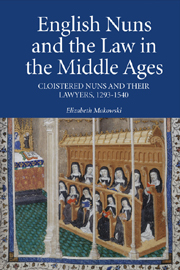4 - Proceedings at Common Law
from II - Select Cases
Published online by Cambridge University Press: 05 April 2013
Summary
We generally picture monasteries as rural retreats, economically dependent on the proceeds from pasture, field, and grange. A glance at the listed real property held by the Aldgate Minoresses dispels that image immediately. Founded on a plot of land in the parish of St Botolph, just outside the walls of London, the economic health of this community rested soundly on the possession of urban real estate. Holdings included residential units, dozens of shops, and even a wharf. As landlords of considerable rental property, the nuns of Aldgate were frequent litigants in the assize courts of London. Centuries of accumulated urban privileges had given London courts a flavor unique to that city, but like other assizes across England, they remained circuit courts ordinarily overseen by superior court justices.
The London Assize of Nuisance was the court that dealt with property disputes between neighbors in the crowded metropolis. ‘Nuisance’ was a legal category that encompassed any disturbing or annoying conduct without direct physical harm. When a tenant's enjoyment of his or her property was disturbed, but there had been no forcible trespass or ouster involved, the case would come before such an assize. An aggrieved party had a limited right of self-help, which meant that he could try to stop the disturbance or carry on his business in spite of it, but he would have to take the matter to court in order to be awarded damages and to have the nuisance completely cleared up by the offending neighbor. Recognitors, investigators sent by the court to the site of the alleged disturbance, ruled for either plaintiff or defendant.
- Type
- Chapter
- Information
- English Nuns and the Law in the Middle AgesCloistered Nuns and their Lawyers, 1293–1540, pp. 71 - 100Publisher: Boydell & BrewerPrint publication year: 2012



